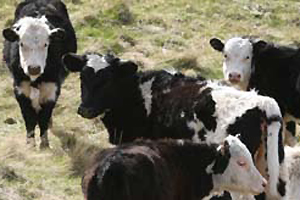The climate conditions present in the region, as well as its relief and soil, prevent intense and widespread farming in Magallanes. Due to this, greenhouses and taking advantage of microclimates are both typical in this zone. Crops worth mentioning are potatoes and fruits and vegetable products.
According to the VII Agropecuary and Forestry National Census, the sowed surface of this region reaches 21,618 hectares. Of this total, 20,855.30 hectares correspond to irrigated crops and the rest to unirrigated crops.
Livestock
In this area, the region of Magallanes offers up a much more developed scenario. So much so, that the main source of work and sustenance for the rural population is livestock, especially the breeding of ovine cattle. This economic activity is focused on the meat and wool market.
The presence of grasses that grow spontaneously along the Patagonian steppe and in a few meadows favors livestock farming activity because it makes up the animals food.
According to the report of the VII Agropecuary Census, in Magallanes there are 3,596,254.47 hectares taken up by cattle ranching. The ovine animals bred add up to 2,205,270. There are also 141,759 heads of bovine cattle and 1,670 hogs, among other animals.
Industry
As part of industrial activities, stand outs include work related to sea products, livestock and saw mills, but, above all, tasks devoted to the extraction and production of hydrocarbons, specifically, oil and natural gas along the eastern mouth of the straight of Magellan.
In the last five years, local exports garnered from industrial tasks have grown due to the shipping of methanol and petroleum ether. Together, they represent around 60% of the region’s total exports.
Forestry
Forestry activities are important in zones where there are native forests, like Tierra del Fuego. However, this precious natural resource is exposed to deforestation caused by fires and erosion.
According to the last Agropecuary Census (in 2007), in the region of Magallanes there are 211,139.34 hectares of native forests and 166,159.11 hectares allocated towards forest exports.
Fishing
Fishing activities take place at both a small scale and an industrial level. Mollusks are extracted, such as snail, mytilidae and southern oysters. Crustaceans are also included, like spider crabs and king crab. When it comes to fish, stand outs are the pink cusk-eels, the merluza and the silver salmon. Likewise, salmon farming has a significant place.
Exports
The main products exported from the region of Magallanes are methanol and petroleum ether. They are followed by fuel oils, sea products and agropecuary products.
The exports towards nations that are members of Mercosur are the ones that deliver the highest profits to the region, according to the 2008 April-June report from the Inacer (Regional Economic Activity Index). Next come the exports to Apec members, and below them are the exports sent to the European Union.
As a consequence of the Free Trade Agreement between Chile and South Korea, king crab, snails, eels and manta rays also stand out as important export products.
Apart from this Asian nation, other noteworthy destinations for Magellanic exports are Holland, Canada, Argentina and Brazil.








